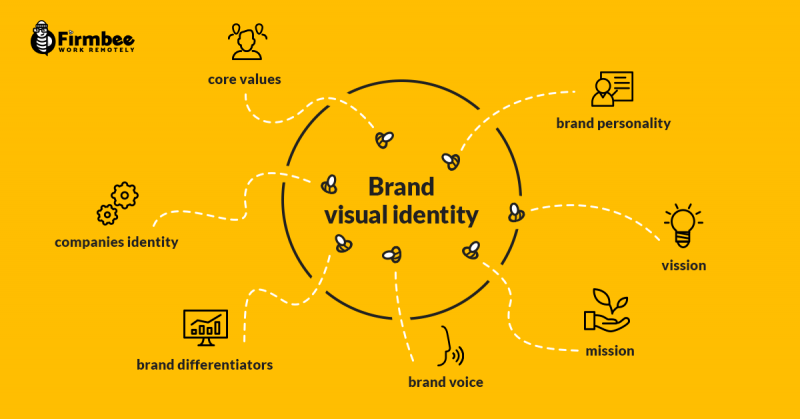Stop for a moment and consider some of your favorite brands. Think of products, services, commercials you may have seen on TV recently – anything you don’t hesitate to spend money on. What is the first thing you think of? It is their logo, colors, and branding? All this makes up a brand’s visual identity.
It is easy to visualize our favorite company’s brand immediately. Why? Because we’re all expert visualizers. We imagine things in pictures, and those pictures make an impression.
Graphic designers know that already, so they translate concepts into graphical forms to communicate with us. They invent symbols to evoke specific ideas or feelings and combine them in meaningful ways to create a unique message.
The same is true for your brand’s visual identity – how your company or organization looks communicates directly with people. Yet when it comes time to shape their brand, too many business leaders rely on their own personalities as the basis for their branding – what the company stands for, how it acts, even how it looks.
Often this results in an identity that’s a confusing mishmash of haphazardly selected logos and branding. The key is to start your brand design by understanding your company’s identity – who the company is and the problems it solves – and taking that identity into your visual representation.
As you can see, many things affect your brand’s visual identity.

How to define and create your brand’s visual identity
Because companies are made up of people, and people see themselves reflected in everything they do, your brand’s identity will resemble you: honest one day, surreptitious the next; passionate here but reserved over there.
Your brand’s visual identity needs to reflect the values of your consumers. Therefore, you should create a brand identity based partially on who your customers think you are: their perception of you is key to building relationships, whether you’re a company or an individual.
In defining your brand identity, ask yourself these questions:
- What is your brand’s personality? What are its roles and responsibilities?
- How do you want it to be perceived (by customers, employees, suppliers?)
- What makes it distinct in the marketplace?
- How does your company fit into its environment?
- Do you need a simple logo, or are more complex graphic solutions required?
- Where is your brand going – next year, five years from now – and how will it get there?
A brand identity tells consumers about your values, what sets you apart from other brands, and why people should choose you over your competitors. It also depicts the purpose of your business.
The first step to brand visualization is writing it down
Once you have defined your brand identity, writing it down is vital. A written brand statement can answer all the questions you never thought to ask yourself. It will also help everyone involved in shaping the brand – from top management to graphic designers – see where they fit into its big picture and take that vision into action. Now it is time to create that identity into a visual brand.
A solid brand’s visual identity reflects tells more than s thousand words:
- What kind of products are you selling?
- Who are your customers?
- What do they want from you, and what do you want from them?
Answering these questions will help you decide the most effective way to reach your target audience: through advertising, public relations, or customer care. The clearer you can be about who you are and what makes your brand unique, the easier it will be to communicate that message.
How to use your brand’s visual identity effectively
The way your brand is represented visually will influence the way it is perceived. Every element you add – from typeface to logo, color to white space – must be there for a reason, contained in the framework of what makes your business unique.

Before making the final decision, it’s good to check how your brand colors, logo or logotype will look like in context fx. on a business card.
Whether you are working on a new identity or refreshing an existing one, it’s essential to recognize that first impressions are vital. Your customer forms an opinion about your company based on initial contact, and this impression sticks with them throughout their relationship with you.
Strive for impact: Make sure your visual design reflects not just who you are now but where you want to go; the more striking and different your image, the greater its impact and ability to stand out from competitors’ brands will be.
Remain flexible: Have a clear idea of what you want to achieve but don’t be afraid to change tack if needed. Remember that design is about communication; it’s not the final destination, but a tool to help get there.
Be authentic: Your brand should reflect your company’s mission and values in everything you do – from ad campaigns to packaging, website design, and product delivery. If you can’t align what is presented with what is represented, your customer will never feel truly connected with your company or its products.
Create a foundation for growth: The visual representation of your brand should be flexible enough to grow with you as you change and evolve over time. This is where consistency in your brand’s visual identity comes into play.
Invest in your brand today for growth tomorrow
In today’s competitive marketplace, the brand’s visual identity can be the key differentiator.
Don’t get lost in the details. Remember that your brand identity is the “face” your company presents to its customers and potential audiences. It reflects what you are as a business, who your customers are, and where you want to go.
Invest in that design early, and you can enjoy growth over time no matter where your business takes you!
Want to stay in touch with our content? Join our Facebook community
Author: Laura Green
There’s probably no social media channel or tactic that Laura doesn’t feel confident about. Whether it’s jumping on the latest TikTok trend, launching a Pinterest campaign, or live-streaming on YouTube - this Social Media Ninja has done it all.


















